标准考虑的平板系统
澳大利亚标准确立了钢筋混凝土板设计的最低要求, 例如单向和双向类型. 关于平面配置和梁的包含, 楼板也可以分为四面支撑的楼板, 梁板系统, 平板, 和平板. 下图总结了这些类型.
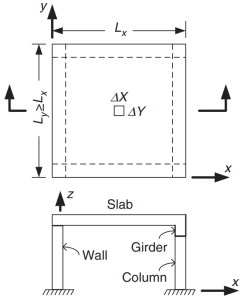
数字 1. 四面支撑板. (红豆杉 & 桑努尔拥抱乔杜里 , “钢筋和预应力混凝土”, 2第二版, 剑桥大学出版社).
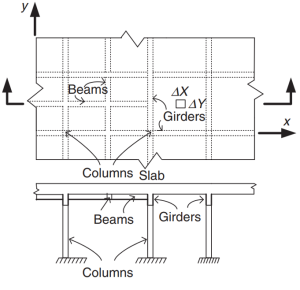
数字 2. 格栅板系统. (红豆杉 & 桑努尔拥抱乔杜里 , “钢筋和预应力混凝土”, 2第二版, 剑桥大学出版社).
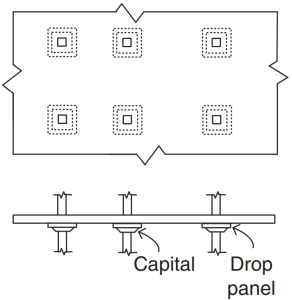
数字 3. 平板. (红豆杉 & 桑努尔拥抱乔杜里 , “钢筋和预应力混凝土”, 2第二版, 剑桥大学出版社).
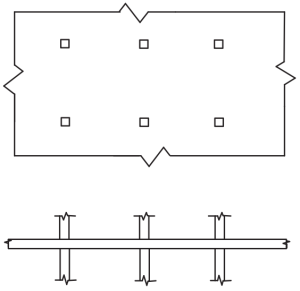
数字 4. 平板. (红豆杉 & 桑努尔拥抱乔杜里 , “钢筋和预应力混凝土”, 2第二版, 剑桥大学出版社).
标准推荐了一些方法 (简化且经过验证的程序) 在确定弯矩:
- 条款 6.10.2: 连续梁和单向板
- 条款 6.10.3: 四侧支撑的双向板
- 条款 6.10.4: 具有多个跨度的双向板
该规范的目的是设计板系统中主要方向的钢筋总量. 将计算钢筋的弯矩 “Mx” 和 “我的。” 数字 5 显示有限板单元中的其他力或作用,其中代码规定了它们的阻力值.

数字 5. 有限板单元中的力: 弯矩 (Mx, 我的), 扭曲的时刻 (米xy, 粘液), 和剪刀 (Qx, Qy). (红豆杉 & 桑努尔拥抱乔杜里 , “钢筋和预应力混凝土”, 2第二版, 剑桥大学出版社)
在这篇文章中, 我们将开发两个板设计示例, 单向和双向板系统, 使用规范导向和允许的简化方法. 在这两种情况下, 我们将创建一个 SkyCiv S3D 模型并将结果与上述方法进行比较.
如果你是 SkyCiv 的新手, 自行注册并测试软件!
单向板设计示例
下图是我们要设计的小建筑和楼板
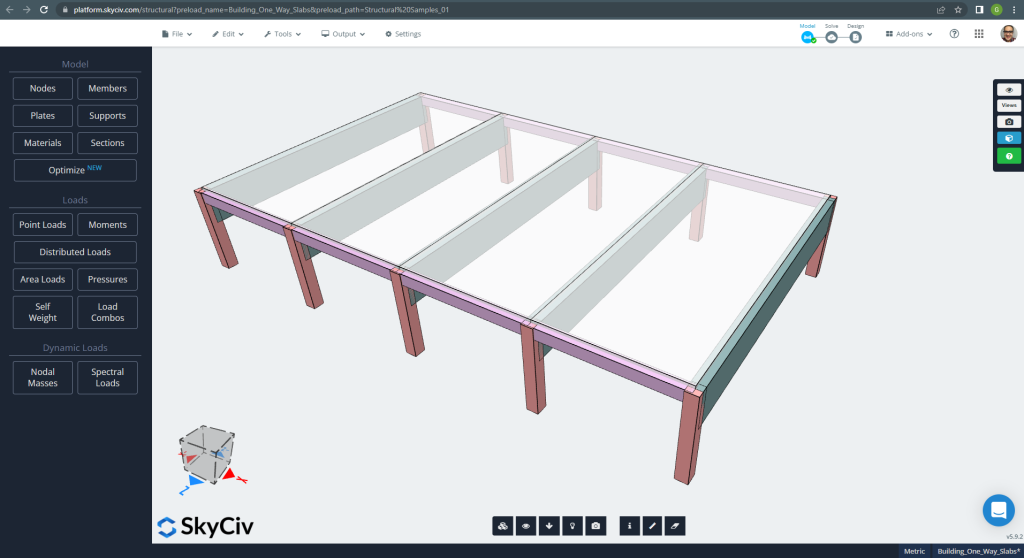
数字 6. 小型建筑中的单向板示例. (结构3D, SkyCiv 云工程).
平面图尺寸如下所示
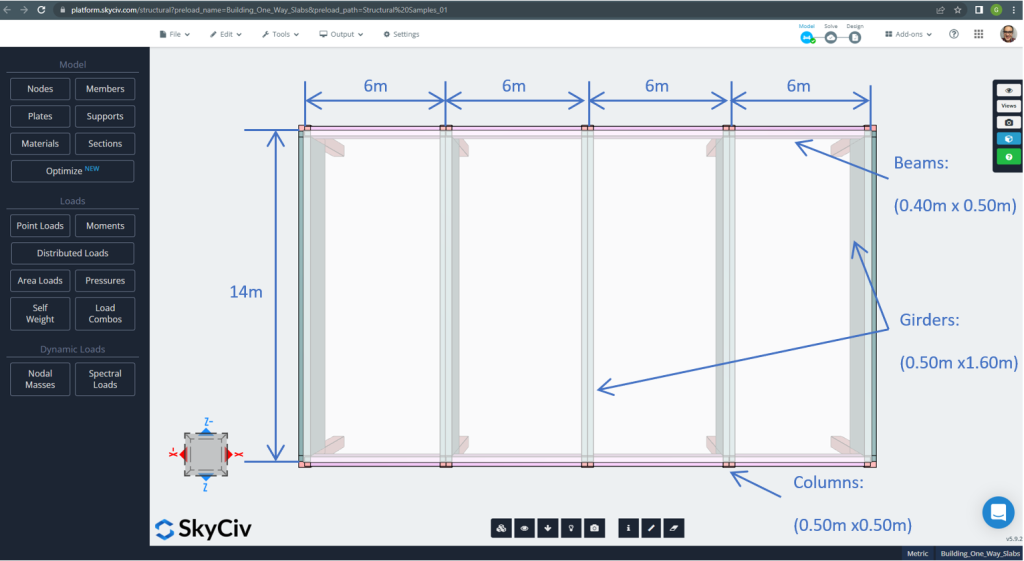
数字 7. 平面尺寸和结构要素. (结构3D, SkyCiv 云工程).
对于平板示例, 总之, 材料, 元素属性, 和需要考虑的负载 :
- 板型分类: 一 – 方式行为 \(\压裂{L_2}{L_1} > 2 ; \压裂{14米}{6米}=2.33 > 2.00 \) 好的!
- 建筑占用: 住宅用途
- 板坯厚度 \(t_{平板}=0.25m)
- 假设钢筋比为的钢筋混凝土密度 0.5% \(\罗_w = 24 \压裂{千牛}{米^3} + 0.6 \压裂{千牛}{米^3} \次 0.5 = 24.3 \压裂{千牛}{米^3} \)
- 混凝土特性抗压强度 28 天 \(f'c = 25 兆帕 \)
- 澳大利亚标准混凝土弹性模量 \(E_c = 26700 兆帕 \)
- 板坯自重 \(死亡 = rho_w times t_{平板} = 24.3 \压裂{千牛}{米^3} \乘以 0.25m = 6.075 \压裂 {千牛}{米^2}\)
- 超载恒载 \(标准差= 3.0 \压裂 {千牛}{米^2}\)
- 活荷载 \(L = 2.0 \压裂 {千牛}{米^2}\)
根据AS3600标准手工计算
在这个部分, 我们将参考澳大利亚标准计算所需的钢筋. 我们首先获得由板的单一宽度条带执行的总因子弯矩.
- 恒载, \(g = (3.0 + 6.075) \压裂{千牛}{米^2} \次 1 m = 9.075 \压裂{千牛}{米}\)
- 活荷载, \(q = (2.0) \压裂{千牛}{米^2} \次 1 m = 2.0 \压裂{千牛}{米}\)
- 极限载荷, \(Fd = 1.2\times g + 1.5\乘以 q = (1.2\次 9.075 + 1.5\次 2.0)\压裂{千牛}{米} =13.89 \frac{千牛}{米} \)
采用标准规定的简化方法, 第一, 必须遵守以下限制:
- \(\压裂{L_i}{L_j} \这 1.2 . \压裂{6米}{6米} =1 < 1.2 \). 好的!
- 负载必须均匀. 好的!
- \(q \le 2g. q=2 \frac{千牛}{米} < 18.15 \压裂{千牛}{米}\). 好的!
- 板坯横截面必须均匀. 好的!.
推荐最小厚度, d
\(d \ge \frac{L_{铁}}{{k_3}{k_4}{\sqrt[3]{\压裂{\压裂{\三角洲}{L_{ef}}{E_c}}{F_{d, ef}}}}}\)
在哪里
- \(k_3= 1.0; k_4= 1.75 \)
- \(\压裂{\三角洲}{L_{ef}}=1/250 \)
- \(E_c = 27600 兆帕 \)
- \(F_{d,ef} = (1.0 +钢底板设计欧洲规范{cs})\次g + (\psi_s + 钢底板设计欧洲规范{cs}\times \psi_1) \乘q=(1.0+0.8)\次 9.075 + (0.7+0.8\次 0.4)\次 2 = 18.375 kPa\)
- \(\psi_s = 0.7 \) 活荷载短期系数
- \(\psi_1= 0.4 \) 活荷载长期系数
- \(钢底板设计欧洲规范{cs} = 0.8 \)
\(d \ge \frac{5.50米}{{1.0}\次 {1.75}{\sqrt[3]{\压裂{\压裂{1}{250}\次{27600 \乘以 10^3 kPa}}{18.375 千帕}}}} \0.173m. d=0.25m > 0.173米 \) 好的!
一旦我们证明满足约束条件, 使用以下表达式计算弯矩: \(M=\alpha \times F_d \times L_n^2\) 哪里 \(\alpha\) 是下图定义的常量.
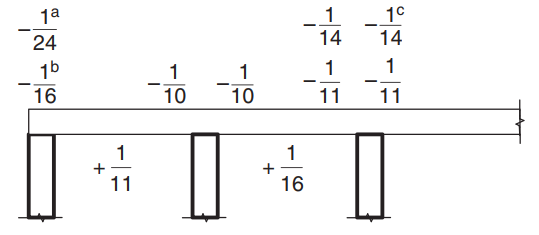
数字 8. 力矩系数值 \(\alpha\) 对于超过两个跨度的板. (红豆杉 & 桑努尔拥抱乔杜里 , “钢筋和预应力混凝土”, 2第二版, 剑桥大学出版社).
在哪里:
- (一个) 梁支撑上的板和梁案例
- (b) 仅适用于连续梁支撑
- (C) 使用 L 级钢筋的地方
- \(L_n \) 是单一带材跨度
- \(F_d \) 是重力因子载荷
对于平板示例, 我们必须使用案例 (一个) 因为板放置在坚硬的大梁上. 只说明一种情况,其余情况如下表所示. 我们还包括钢筋面积计算.
- \(米={\α} {F_d}{L_n^2}={-\压裂{1}{24}}\次 {13.89 \压裂{千牛}{米}}\次 (6米-0.5米)可以假设为 – 17.51{千牛}{米}\)
- 盖=20mm (耐火期至少需要10mm 60 分钟).
- \(d = t_{平板} – 覆盖 – \压裂{棒材直径}{2} = 250毫米 – 20毫米 – 6毫米=224毫米 \)
- \(\阿尔法_2= 1.0-0.003 f’c = 1.0-0.003\times 25 = 0.925 (0.67 \le \alpha_2 \le 0.85) \) 从而, 我们选择 \(\阿尔法_2= 0.85\)
- \(\xi = \frac{\alpha_2\times f’c}{F_{他的}} = frac{0.85\次 25 兆帕}{500 兆帕} = 0.0425 \)
- \(\rho_t = \xi – \sqrt{{\习}^ 2 – \压裂{{2}{\习}{m}}{{\φ}{b}{d^2}{F_{他的}}}} = 0.0425 – \sqrt{{0.0425}^2-\frac{2\times 0.0425\times 17.51{千牛}{米}}{{0.8}\次 {1米}\次 {{(0.224米)^ 2}} \次 {500\次 {10^ 3}千帕}}}=0.0008814\)
- \(\伽玛= 1.05-0.007 f’c = 1.05-0.007\times 25 = 0.875 (0.67 \le \gamma \le 0.85) \) 从而, 我们选择 \(\伽马= 0.85\)
- \(k_u = \frac{\rho_t \times f_{他的}}{0.85\times \gamma \times f’c}= 分数{0.0008814\次 500 兆帕}{0.85\次 0.85 \次 25 兆帕} =0.0244\)
- \(\Φ= 1.19 – \压裂{13\钢底板设计欧洲规范{u0}}{12} = 1.19 – \压裂{13\次 0.0244}{12} = 1.164 (0.6 \le \phi \le 0.8) \) 从而, 我们选择 \(\Φ= 0.8\). 好的!.
- \(\o{Ť,分} = 0.20 {(\压裂{d}{d})^ 2}{(\压裂{F'_{ct,F}}{F_{他的}})} = 0.20 \次 (\压裂{0.25米}{0.224米})^2 \times \frac{0.6\次 sqrt{25兆帕}}{500 兆帕} = 0.0015\)
- \(一个_{圣}=最大(\o{Ť,分}, \罗_t)\times b \times d = max(0.0015,0.0008814)\次 1000 mm \times 224 毫米= 334.82 毫米^2 \)
| \(\alpha\) 和时刻 | 外部负左 | 外部积极 | 外部负权 | 内部负左 | 内部积极 | 内部负权 |
|---|---|---|---|---|---|---|
| \(\alpha\) 值 | -\(\压裂{1}{24}\) | \(\压裂{1}{11}\) | -\(\压裂{1}{10}\) | \(\压裂{1}{10}\) | \(\压裂{1}{16}\) | \(\压裂{1}{11}\) |
| M值 | -17.51 | 38.20 | -42.02 | 42.02 | 26.26 | 38.20 |
| \(\rho_t\) | 0.0008814 | 0.001948 | 0.002148 | 0.002148 | 0.00133 | 0.001948 |
| 到 | 0.0244 | 0.0539 | 0.0594 | 0.0594 | 0.0368 | 0.05391 |
| \(\φ) | 0.8 | 0.8 | 0.8 | 0.8 | 0.8 | 0.8 |
| \(一个_{圣} {毫米^2}\) | 334.82 | 436.31 | 481.099 | 481.099 | 334.8214 | 436.3100 |
钢筋面积计算后, 您可以定义细节 (将钢筋放置到板中的实际方法). 作为您了解的帮助, 我们分享下面的图片, 指示正弯矩和负弯矩的钢筋位置:
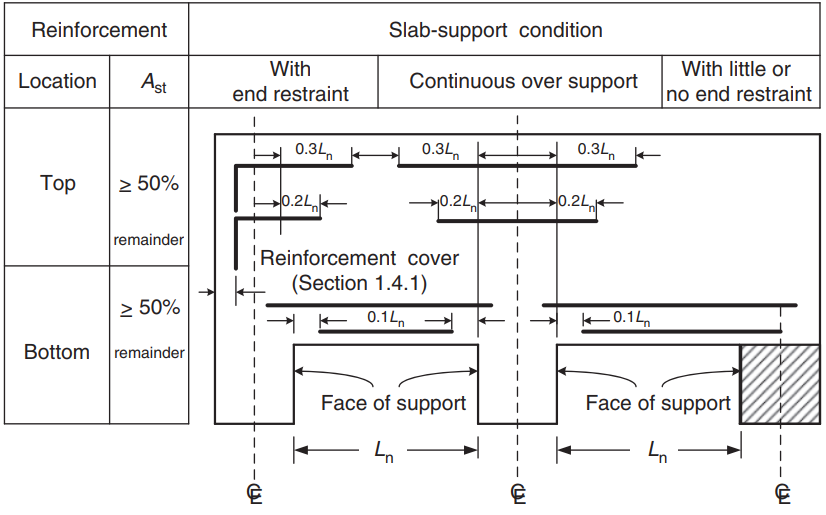
数字 9. 单向板和双向板的加固布置. (红豆杉 & 桑努尔拥抱乔杜里 , “钢筋和预应力混凝土”, 2第二版, 剑桥大学出版社)
如果你是 SkyCiv 的新手, 自行注册并测试软件!
SkyCiv S3D 板设计模块结果
在第一个视图中, 我们将展示一些用于 S3D 中示例的建模和结构分析的图像. 我们建议您在以下链接中阅读有关 SkyCiv 建模的信息 如何对板进行建模? 和 使用 SkyCiv 的 ACI 板设计示例.
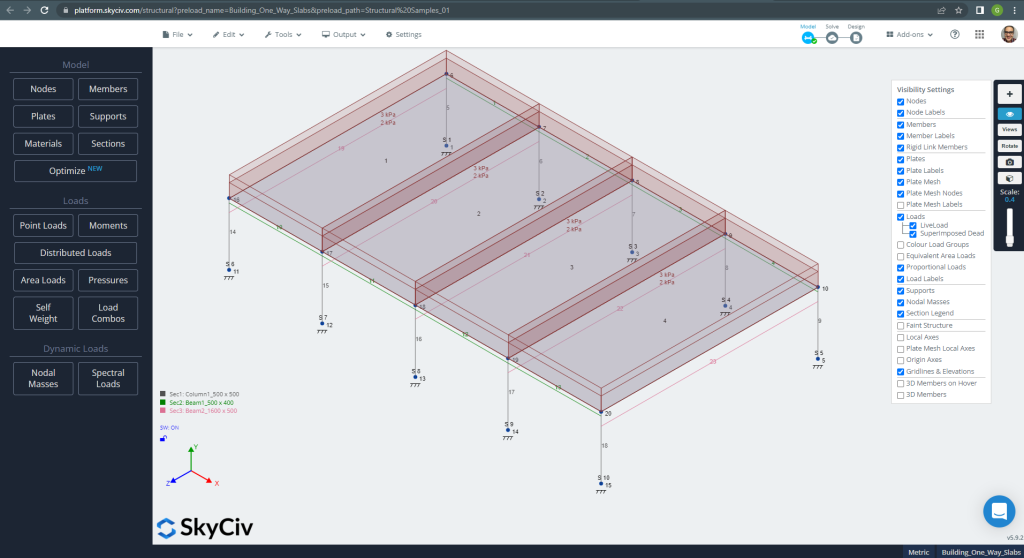
数字 10. 单向板示例的 S3D 结构模型. (结构3D, SkyCiv 云工程).
在分析模型之前, 我们必须定义板网格尺寸. 一些参考资料 (2) 推荐的壳单元尺寸为 1/6 短跨度或 1/8 长跨度的, 其中较短的一个. 遵循这个值, 我们有 \(\压裂{L2}{6}= 分数{6米}{6} = 1 米 \) 要么 \(\压裂{L1}{8}= 分数{14米}{8}=1.75m \); 我们以 1m 作为最大推荐尺寸,并采用 0.50m 的网格尺寸.
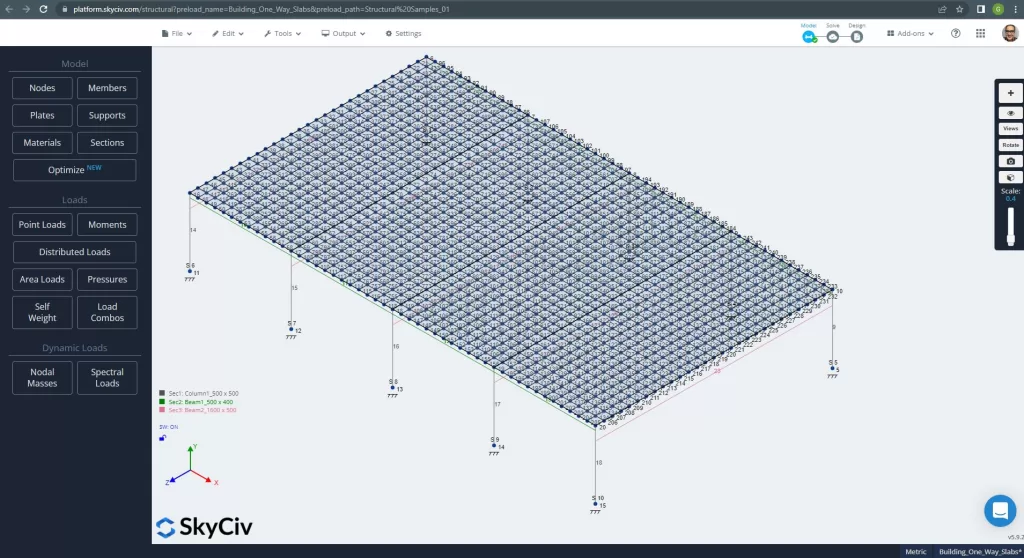
数字 11. 改进板中的网格. (结构3D, SkyCiv 云工程).
一旦我们改进了分析结构模型, 我们进行线性弹性分析. 设计楼板时, 我们必须检查垂直位移是否小于代码允许的最大值. 澳大利亚标准规定了最大可维修性垂直位移 \(\压裂{大号}{250}= 分数{6000毫米}{250}=24.0 mm\).
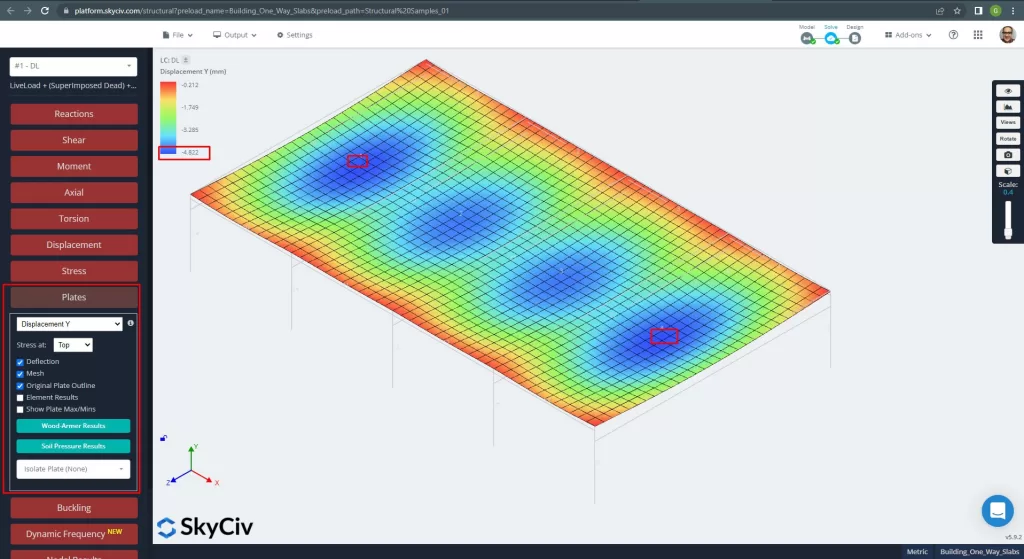
数字 12. 板的垂直位移. (结构3D, SkyCiv 云工程).
将最大垂直位移与规范参考值进行比较, 板的刚度足够. \(4.822 毫米 < 24.00mm\).
板跨度中的最大力矩位于中心,负力矩位于外部和内部支撑处. 让我们在下图中查看这些时刻值.
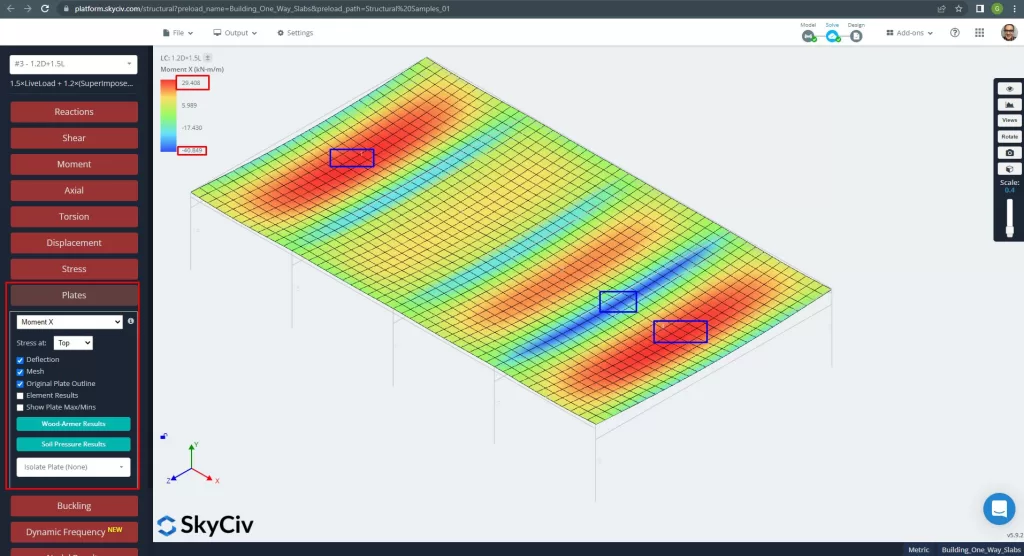
数字 13. X 方向的力矩. (结构3D, SkyCiv 云工程).
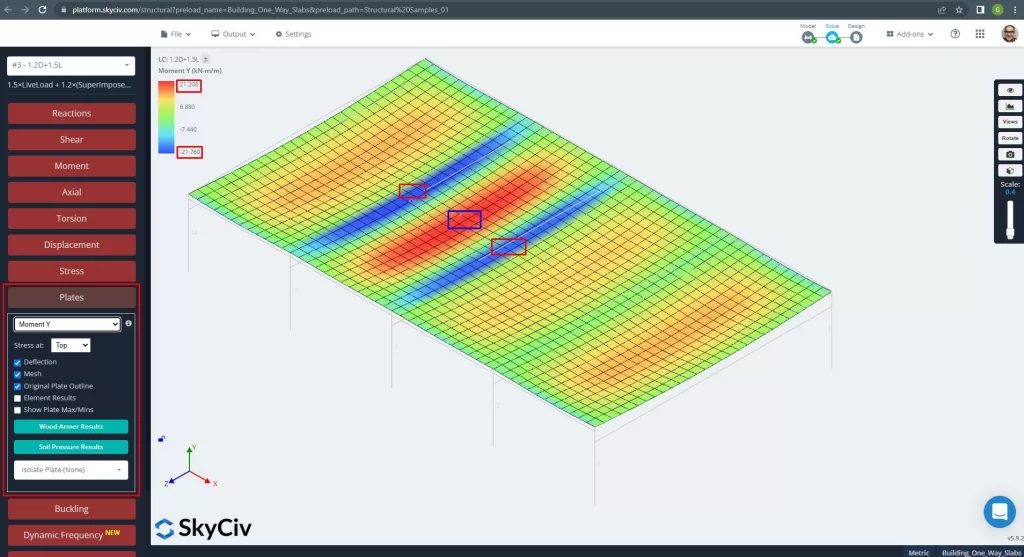
数字 14. Y 方向的力矩. (结构3D, SkyCiv 云工程).
板单元局部轴如下所示.
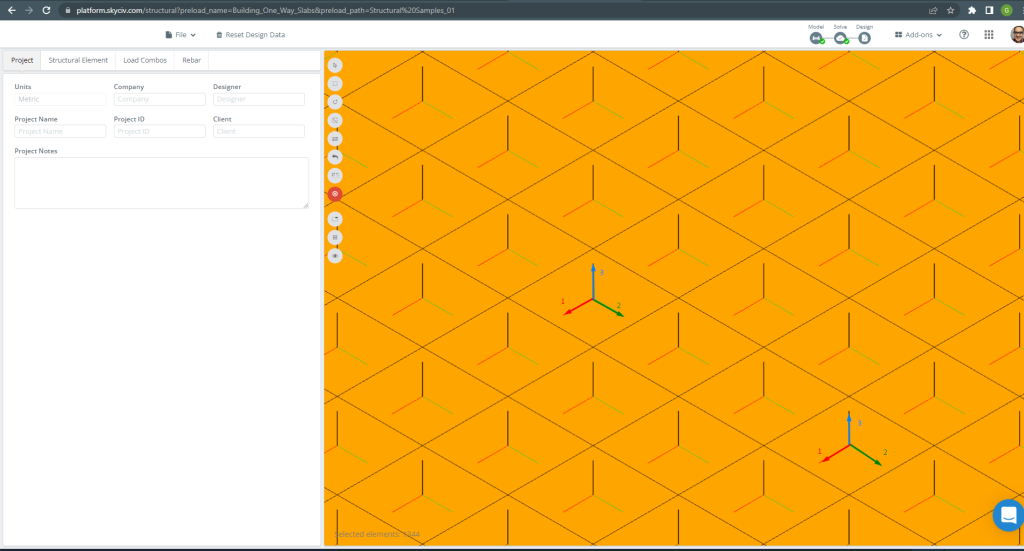
数字 15. 板局部轴. (结构3D, SkyCiv 云工程).
有关自动化钢筋板设计的更多详细信息, 请参阅我们的文档 SkyCiv 中的板块.
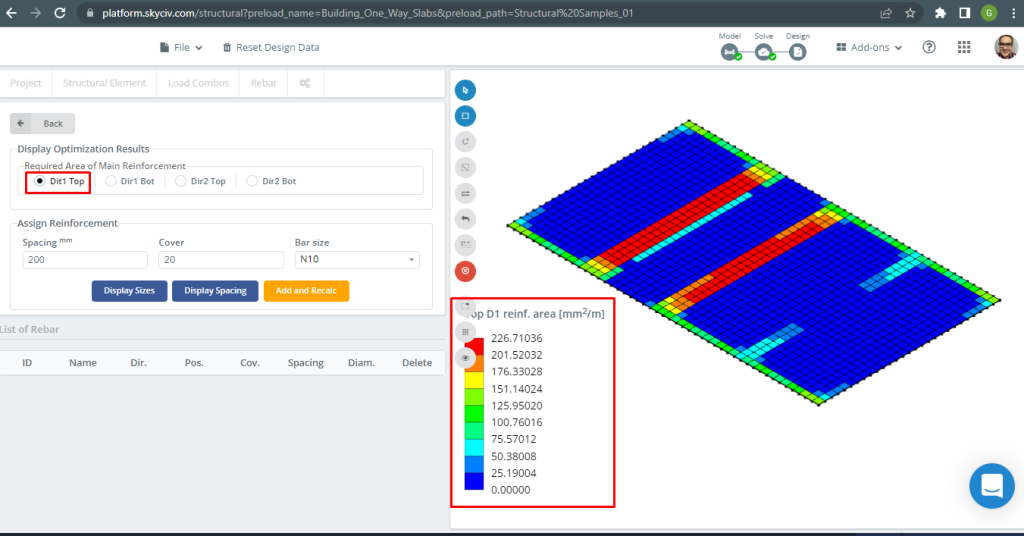
数字 16. 顶部D1加固. (结构3D, SkyCiv 云工程).

数字 17. 底部D1加固. (结构3D, SkyCiv 云工程).
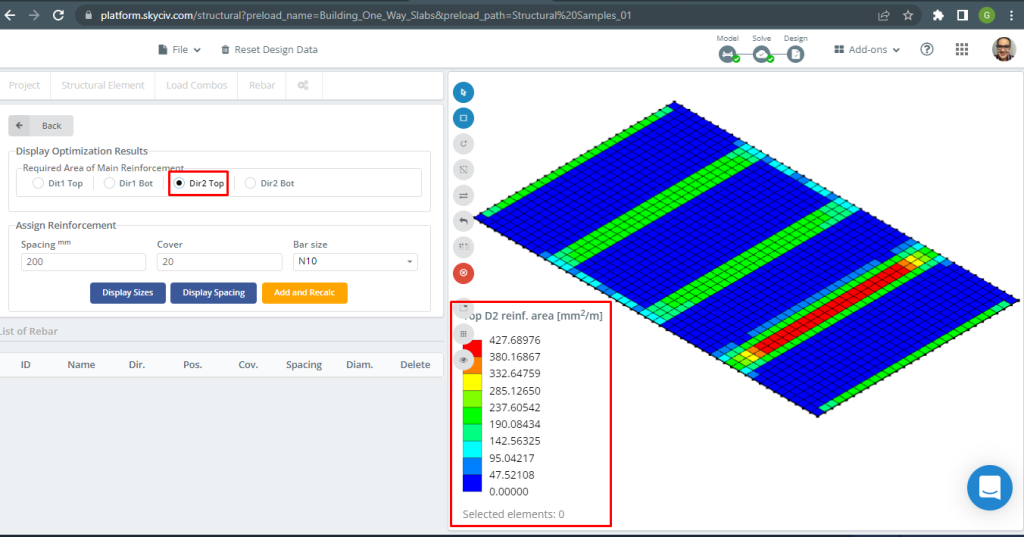
数字 18. 顶部 D2 加固. (结构3D, SkyCiv 云工程).
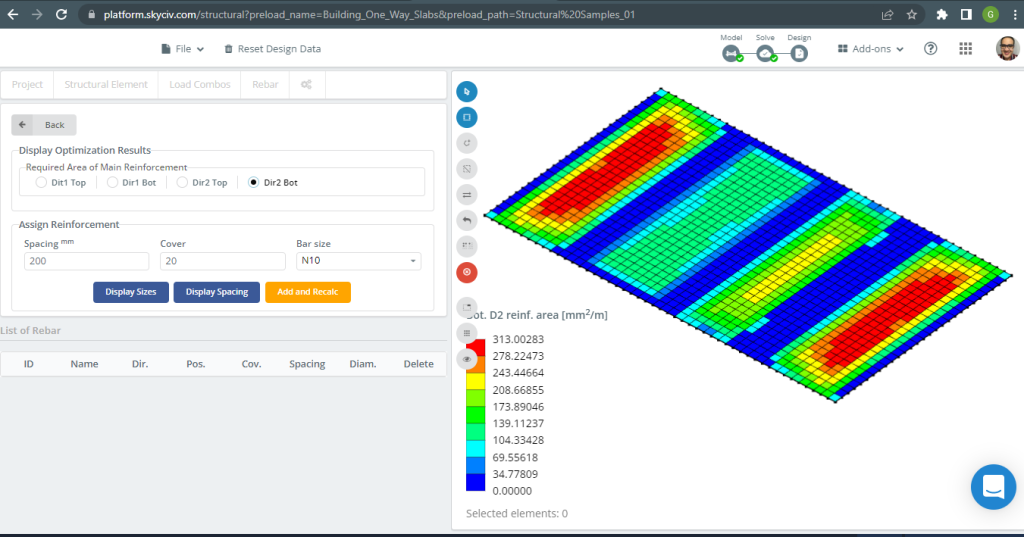
数字 19. 底部D2加固. (结构3D, SkyCiv 云工程).
结果比较
此单向板设计示例的最后一步是比较通过 S3D 分析获得的钢筋面积 (局部轴 “2”) 和手工计算.
| 力矩和钢面积 | 外部负左 | 外部积极 | 外部负权 | 内部负左 | 内部积极 | 内部负权 |
|---|---|---|---|---|---|---|
| \(一个_{圣, 手算} {毫米^2}\) | 334.82 | 436.31 | 481.099 | 481.099 | 334.8214 | 436.3100 |
| \(一个_{圣, S3D} {毫米^2}\) | 285.13 | 313.00 | 427.69 | 427.69 | 313.00 | 427.69 |
| \(\三角洲_{差异}\) (%) | 14.84 | 28.262 | 11.101 | 11.101 | 6.517 | 1.986 |
我们可以看到数值的结果非常接近. 这意味着计算是正确的!
双向板设计示例
在这个部分, 我们将开发一个由格栅系统组成的示例.
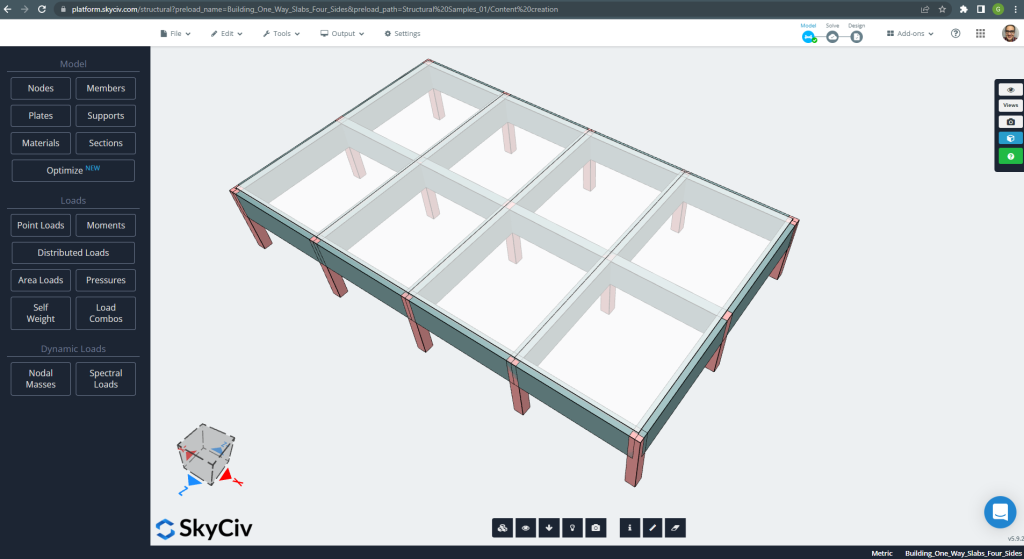
数字 20. 格栅系统. (结构3D, SkyCiv 云工程).
平面图尺寸如下所示
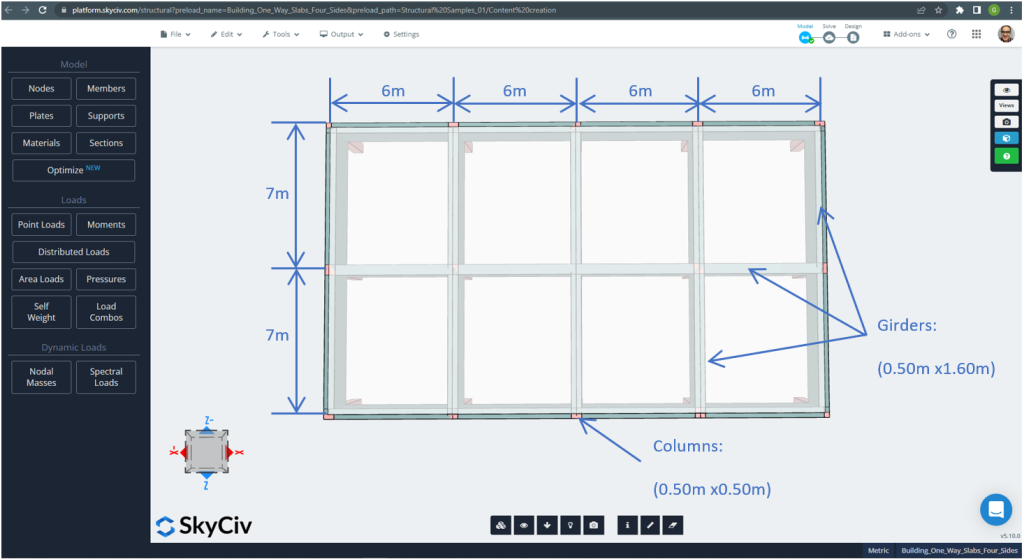
数字 21. 四边双向板示例的平面尺寸. (结构3D, SkyCiv 云工程).
对于平板示例, 总之, 材料, 元素属性, 和需要考虑的负载 :
- 板型分类: 二 – 方式行为 \(\压裂{L_2}{L_1} \这 2 ; \压裂{7米}{6米}=1.167 < 2.00 \) 好的!
- 建筑占用: 住宅用途
- 板坯厚度 \(t_{平板}=0.25m)
- 假设钢筋比为的钢筋混凝土密度 0.5% \(\罗_w = 24 \压裂{千牛}{米^3} + 0.6 \压裂{千牛}{米^3} \次 0.5 = 24.3 \压裂{千牛}{米^3} \)
- 混凝土特性抗压强度 28 天 \(f'c = 25 兆帕 \)
- 澳大利亚标准混凝土弹性模量 \(E_c = 26700 兆帕 \)
- 板坯自重 \(死亡 = rho_w times t_{平板} = 24.3 \压裂{千牛}{米^3} \乘以 0.25m = 6.075 \压裂 {千牛}{米^2}\)
- 超载恒载 \(标准差= 3.0 \压裂 {千牛}{米^2}\)
- 活荷载 \(L = 2.0 \压裂 {千牛}{米^2}\)
根据AS3600标准手工计算
在这个部分, 我们将参考澳大利亚标准计算所需的钢筋. 我们首先获得板的单一宽度条带在每个弯曲主方向上执行的总因子弯矩.
- 恒载, \(g = (3.0 + 6.075) \压裂{千牛}{米^2} \次 1 m = 9.075 \压裂{千牛}{米}\)
- 活荷载, \(q = (2.0) \压裂{千牛}{米^2} \次 1 m = 2.0 \压裂{千牛}{米}\)
- 极限载荷, \(Fd = 1.2\times g + 1.5\乘以 q = (1.2\次 9.075 + 1.5\次 2.0)\压裂{千牛}{米} =13.89 \frac{千牛}{米} \)
设计力矩和系数
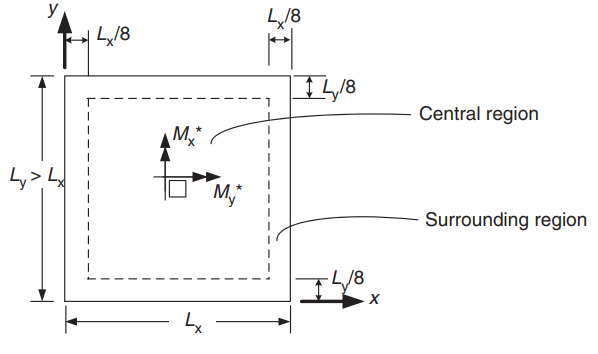
数字 22. 用于确定正力矩的双向板的方向. (红豆杉 & 桑努尔拥抱乔杜里 , “钢筋和预应力混凝土”, 2第二版, 剑桥大学出版社)

数字 23. 双向板中负力矩的确定. (红豆杉 & 桑努尔拥抱乔杜里 , “钢筋和预应力混凝土”, 2第二版, 剑桥大学出版社)
| 边缘条件 | 短跨度系数 (\(\beta_x\)) | 长跨度系数 (\(\贝塔_y)\) 的所有值 \(\压裂{L_y}{L_x}\) | |||||||
|---|---|---|---|---|---|---|---|---|---|
| 的价值 \(\压裂{L_y}{L_x}\) | |||||||||
| 1.0 | 1.1 | 1.2 | 1.3 | 1.4 | 1.5 | 1.75 | \(\葛 2.0\) | ||
| 1. 四边连续 | 0.024 | 0.028 | 0.032 | 0.035 | 0.037 | 0.040 | 0.044 | 0.048 | 0.024 |
| 2. 一条短边不连续 | 0.028 | 0.032 | 0.036 | 0.038 | 0.041 | 0.043 | 0.047 | 0.050 | 0.028 |
| 3. 一长边不连续 | 0.028 | 0.035 | 0.041 | 0.046 | 0.050 | 0.054 | 0.061 | 0.066 | 0.028 |
| 4. 两条短边不连续 | 0.034 | 0.038 | 0.040 | 0.043 | 0.045 | 0.047 | 0.050 | 0.053 | 0.034 |
| 5. 两条长边不连续 | 0.034 | 0.046 | 0.056 | 0.065 | 0.072 | 0.078 | 0.091 | 0.100 | 0.034 |
| 6. 两条相邻边不连续 | 0.035 | 0.041 | 0.046 | 0.051 | 0.055 | 0.058 | 0.065 | 0.070 | 0.035 |
| 7. 三边不连续 (一条长边连续) | 0.043 | 0.049 | 0.053 | 0.057 | 0.061 | 0.064 | 0.069 | 0.074 | 0.043 |
| 8. 三边不连续 (一短边连续) | 0.043 | 0.054 | 0.064 | 0.072 | 0.078 | 0.084 | 0.096 | 0.105 | 0.043 |
| 9. 四边不连续 | 0.056 | 0.066 | 0.074 | 0.081 | 0.087 | 0.093 | 0.103 | 0.111 | 0.056 |
桌子 1. (红豆杉 & 桑努尔拥抱乔杜里 , “钢筋和预应力混凝土”, 2第二版, 剑桥大学出版社)
下图解释了上表提到的所有九种情况
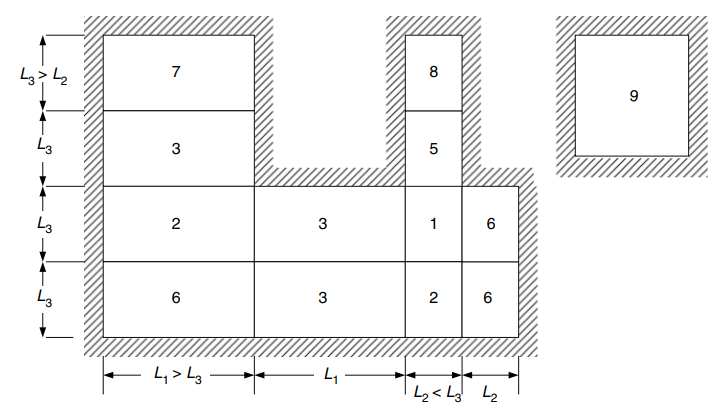
数字 24. 四侧支撑双向板的边缘条件. (红豆杉 & 桑努尔拥抱乔杜里 , “钢筋和预应力混凝土”, 2第二版, 剑桥大学出版社)
中部地区的设计时刻 (案件 6 两条相邻边不连续) :
- \(L_x = 6m, L_y=7m, \压裂{L_y}{L_x} = frac{7米}{6米}= 1.167 \) 要线性插值的值
- 优点:
- \(M_x = {\贝塔_x}{F_d}{L_x^2} = {0.04435}\次 {13.89 \压裂{千牛}{米}}\次{(6米)^ 2}=22.177 kNm\)
- \(M_y = {\贝塔_y}{F_d}{L_x^2} ={0.035}\次 {13.89 \压裂{千牛}{米}}\次{(6米)^ 2}=17.501 kNm \)
- 负外部跨度:
- \(M_{x1,A} = -\lambda_e \times M_x = -0.5 \次 22.177 千牛米= – 11.089 kNm\)
- \(M_{y1,A} = -\lambda_e \times M_y = -0.5 \次 17.501 千牛米= -8.751 千牛·米 \)
- 负片内部跨度:
- \(M_{x1,B} = -\lambda_{1X} \次 M_x = -1.33 \次 22.177 千牛米= – 29.495 kNm\)
- \(M_{y1, 乙} = -\lambda_{1和} \次 M_y = -1.33 \次 17.501 千牛米= -23.276 千牛·米 \)
中部地区的设计时刻 (案件 3 一长边不连续) :
- \(L_x = 6m, L_y=7m, \压裂{L_y}{L_x} = frac{7米}{6米}= 1.167 \) 要线性插值的值
- 优点:
- \(M_x = {\贝塔_x}{F_d}{L_x^2} = {0.03902}\次 {13.89 \压裂{千牛}{米}}\次{(6米)^ 2}= 19.512 kNm\)
- \(M_y = {\贝塔_y}{F_d}{L_x^2} ={0.028}\次 {13.89 \压裂{千牛}{米}}\次{(6米)^ 2}= 14.001 千牛·米 \)
- 负片内部跨度:
- \(M_{x1,B} = -\lambda_{1X} \次 M_x = -1.33 \次 19.512 千牛米= – 25.951 kNm\)
- \(M_{y1,B} = -\lambda_{1和} \次 M_y = -1.33 \次 14.001 千牛米= – 18.621 千牛·米 \)
- 底片内部第二跨度:
- \(M_{x2,B} = -\lambda_{2X} \次 M_x = -1.33 \次 19.512 千牛米= – 25.951 kNm\)
- \(M_{y2,B} = -\lambda_{2和} \次 M_y = -1.33 \次 14.001 千牛米= – 18.621 千牛·米 \)
X方向螺纹钢
| \(\alpha\) 和时刻 | 外部负左 | 外部积极 | 外部负权 | 内部负左 | 内部积极 | 内部负权 |
|---|---|---|---|---|---|---|
| M值 | 11.089 | 22.177 | 29.495 | 25.951 | 19.512 | 25.951 |
| \(\rho_t\) | 0.00055614 | 0.00112 | 0.001496 | 0.001313 | 0.000984 | 0.001313 |
| 到 | 0.015395 | 0.0310 | 0.0414 | 0.0364 | 0.0272 | 0.0364 |
| \(\φ) | 0.8 | 0.8 | 0.8 | 0.8 | 0.8 | 0.8 |
| \(一个_{圣} {毫米^2}\) | 334.8214 | 334.8214 | 335.08233 | 334.821 | 334.8214 | 334.8214 |
Y向螺纹钢
| \(\alpha\) 和时刻 | 外部负左 | 外部积极 | 外部负权 | 内部负左 | 内部积极 | 内部负权 |
|---|---|---|---|---|---|---|
| M值 | 8.751 | 17.501 | 23.276 | 18.621 | 14.001 | 18.621 |
| \(\rho_t\) | 0.0004383 | 0.0008811 | 0.001176 | 0.0009381 | 0.000703 | 0.0009381 |
| 到 | 0.0121 | 0.0244 | 0.03256 | 0.02597 | 0.0195 | 0.02597 |
| \(\φ) | 0.8 | 0.8 | 0.8 | 0.8 | 0.8 | 0.8 |
| \(一个_{圣} {毫米^2}\) | 334.821 | 334.821 | 334.821 | 334.821 | 334.8214 | 334.821 |
如果你是 SkyCiv 的新手, 自行注册并测试软件!
SkyCiv S3D 板设计模块结果
完善模型后, 是时候运行线性弹性分析了.
设计楼板时, 我们必须检查垂直位移是否小于代码允许的最大值. 澳大利亚标准规定了最大可维修性垂直位移 \(\压裂{大号}{250}= 分数{6000毫米}{250}=24.0 mm\).
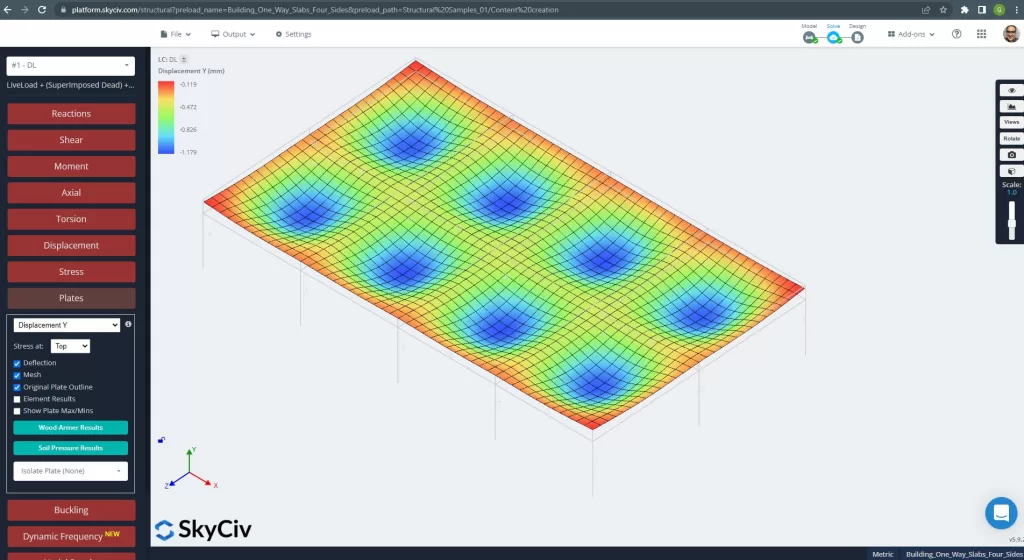
数字 25. 格栅板系统中的垂直位移. (结构3D, SkyCiv 云工程).
上图为我们提供了垂直位移. 最大值为-1.179mm,小于允许的最大值-24mm. 因此, 板坯的刚度足够.
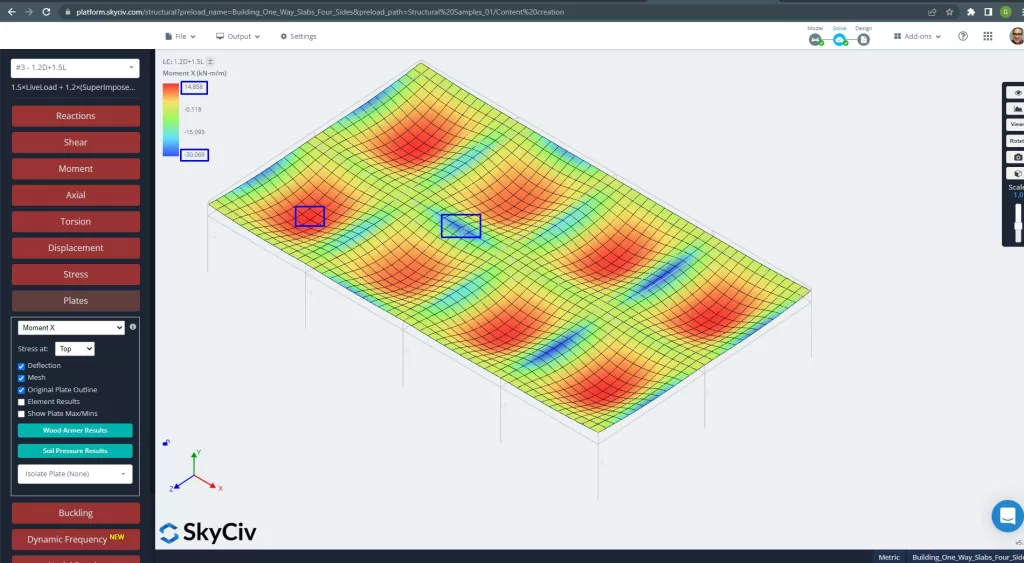
数字 26. X 方向上的板力矩. (结构3D, SkyCiv 云工程).
图片 27 和 28 由每个主方向的弯矩组成. 获取矩分布和值, 软件, SkyCiv, 即可求得总钢筋面积.
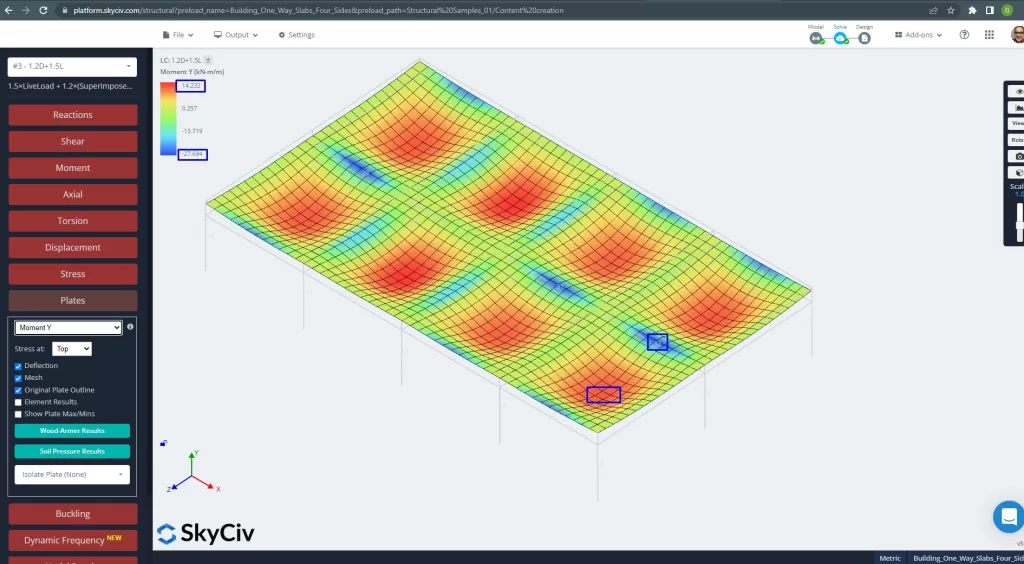
数字 27. 板 Y 方向的力矩. (结构3D, SkyCiv 云工程).
钢筋加固区域:
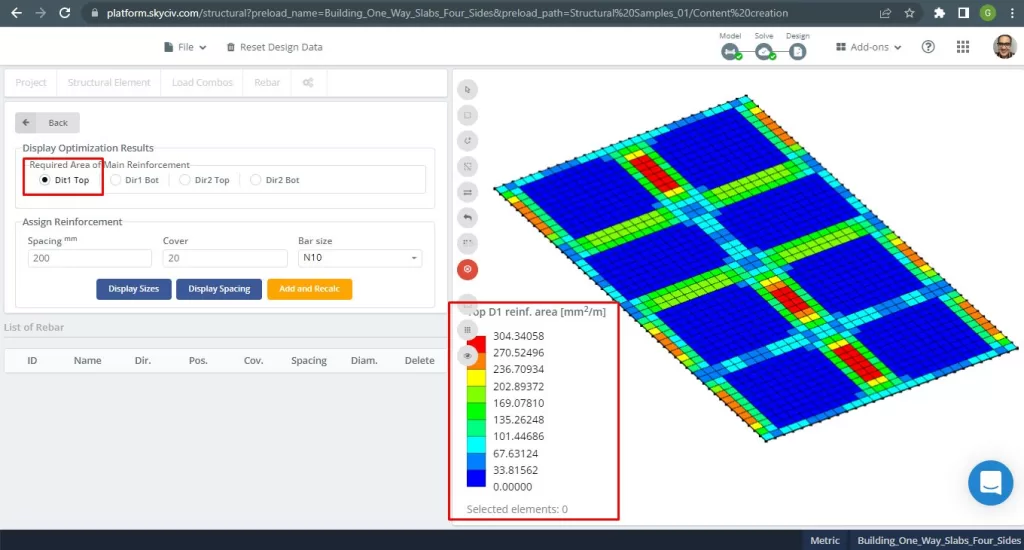
数字 28. 顶部钢筋方向加固 1. (结构3D, SkyCiv 云工程).
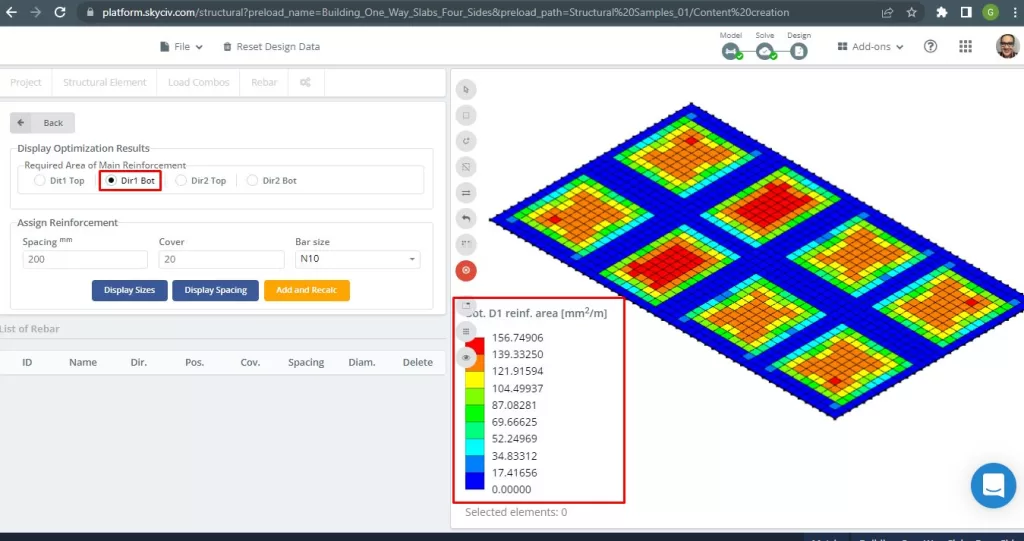
数字 29. 底部钢筋方向钢筋 1. (结构3D, SkyCiv 云工程).
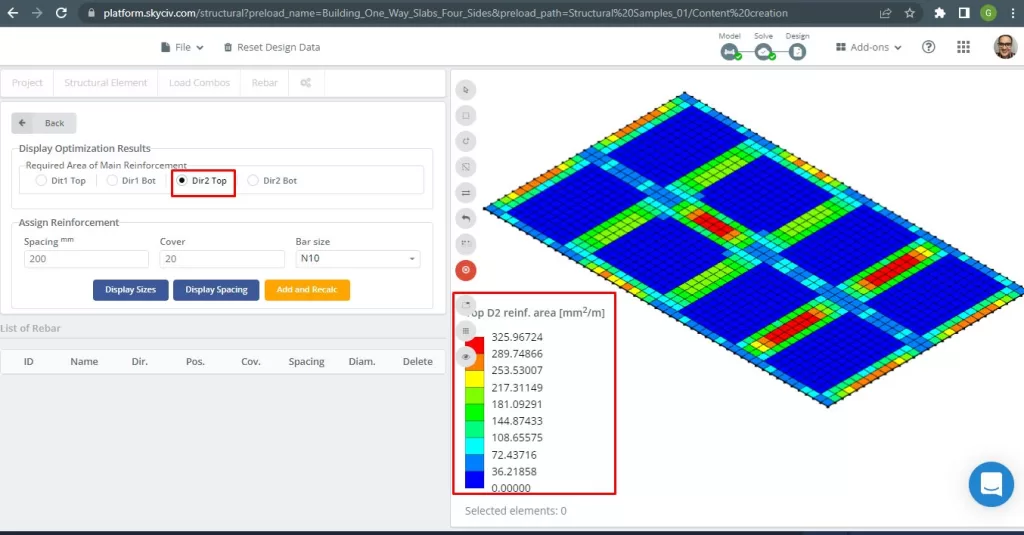
数字 30. 顶部钢筋方向加固 2. (结构3D, SkyCiv 云工程).
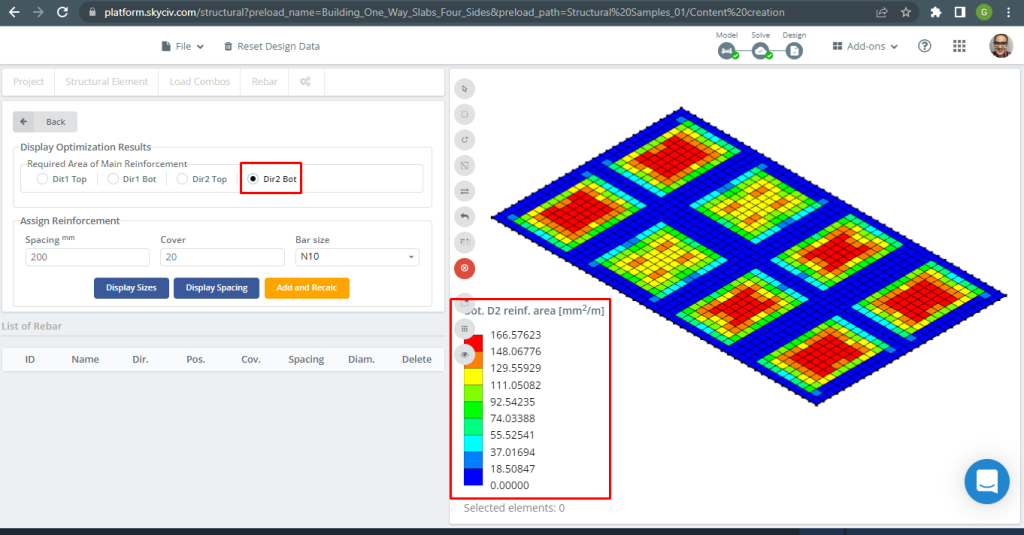
数字 31. 底部钢筋方向钢筋 2. (结构3D, SkyCiv 云工程).
结果比较
此单向板设计示例的最后一步是比较通过 S3D 分析和手工计算获得的钢筋面积.
X方向螺纹钢
| 力矩和钢面积 | 外部负左 | 外部积极 | 外部负权 | 内部负左 | 内部积极 | 内部负权 |
|---|---|---|---|---|---|---|
| \(一个_{圣, 手算} {毫米^2}\) | 334.8214 | 334.8214 | 335.08233 | 334.821 | 334.8214 | 334.8214 |
| \(一个_{圣, S3D} {毫米^2}\) | 289.75 | 149.35 | 325.967 | 325.967 | 116.16 | 217.311 |
| \(\三角洲_{差异}\) (%) | 13.461 | 55.39 | 2.720 | 2.644 | 65.307 | 35.0964 |
Y向螺纹钢
| 力矩和钢面积 | 外部负左 | 外部积极 | 外部负权 | 内部负左 | 内部积极 | 内部负权 |
|---|---|---|---|---|---|---|
| \(一个_{圣, 手算} {毫米^2}\) | 334.821 | 334.821 | 334.821 | 334.821 | 334.821 | 334.821 |
| \(一个_{圣, S3D} {毫米^2}\) | 270.524 | 156.75 | 304.34 | 304.34 | 156.75 | 270.52 |
| \(\三角洲_{差异}\) (%) | 19.203 | 53.184 | 9.104 | 9.104 | 53.184 | 19.204 |
对于正力矩,差异较大,原因是存在高扭转刚度的梁,这会影响板的有限元分析结果和弯曲钢筋的计算.
如果你是 SkyCiv 的新手, 自行注册并测试软件!
参考资料
- 红豆杉 & 桑努尔拥抱乔杜里 , “钢筋和预应力混凝土”, 2第二版, 剑桥大学出版社.
- 巴赞·恩里克 & 梅利·皮拉拉, “结构抗震设计”, 1编辑, 清除.
- 澳大利亚标准, 混凝土结构, 作为 3600:2018


